Human Mobility
Cash and Voucher Assistance (CVA) is frequently used to meet the needs of migrants in crisis. This page serves as a space to house materials connected to CVA and migration.

The Red Cross is preparing to provide humanitarian assistance to migrants ready to depart Honduras for Guatemala as part of a migrant caravan.
©Johannes Chinchilla / IFRC.
Conflict, economic crisis and natural disasters have forced people on arduous and risky journeys across multiple borders in search of safety, security and livelihoods. In 2020, the number of people forcibly displaced soared to a record high of over 80 million – nearly double the number a decade earlier. This trend is worsening and the effects of climate change threaten to displace up to 200 million people by 2050.
Increasingly, cash and voucher assistance (CVA) is being used to meet the needs of people on the move. It has been used at scale in various contexts from the 2015 European migration crises to ‘los caminantes’ from Venezuela. Equally, it has been used in other mixed migration crises, such as Central America, the Sahel, the Mediterranean, and the Horn of Africa. Currently, CVA is one of the main forms of assistance to the displaced populations in Ukraine and the surroundings countries.
There are many perspectives and definitions about what it means to be a migrant and how humanitarians should respond. Intentionally, we are not using a single definition for now as the discussion on CVA and migration is in its early stages a language is evolving.
Documenting and sharing evidence will help improve response effectiveness. This page houses a useful selection of resources related to migrants and the use of CVA. It will be updated as conversations evolve within humanitarian CVA spaces.
Current priorities
We aim to contribute to progress on this issue by:
- Supporting evidence generation at regional and global levels;
- contributing to practical solutions to delivering CVA to migrant populations; and
- convening evidence-based discussion on the key issues.
Featured content

Mapping a Route-Based Approach to CVA: Feasibility in select contexts in the Americas
Report
This research looks at the feasibility of a route-based approach to CVA in the Americas, presenting its potential through three perspectives: people on the move, humanitarian organizations, and financial service providers (FSP).
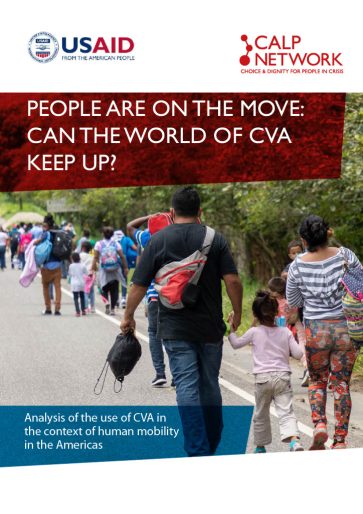
People are on the move: Can the world of CVA keep up? Analysis of the use of CVA in the context of human mobility in the Americas
Report
This study proposes a new vision for the implementation of cash and voucher assistance (CVA) in contexts of human mobility in the Americas region.

Four Reasons to Use a Route-Based Approach to Cash and Voucher Assistance
Blog Post
With human mobility being a fact of most humanitarian crises, is it time to change from a country to a route-based approach? With four key points, Holly Welcome Radice argues the time for a route-based approach has arrived.
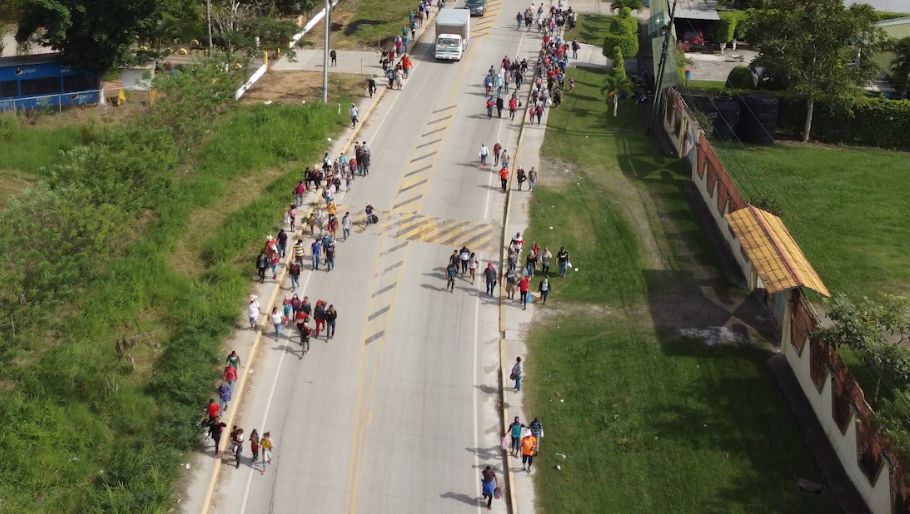
This is not a drill: Cash and human mobility
Blog Post
In this blog Paula Gil Baizan presents three new lenses through which we can view human mobility. She outlines how these lenses intersect with Cash and Voucher Assistance with a particular focus on the Americas.
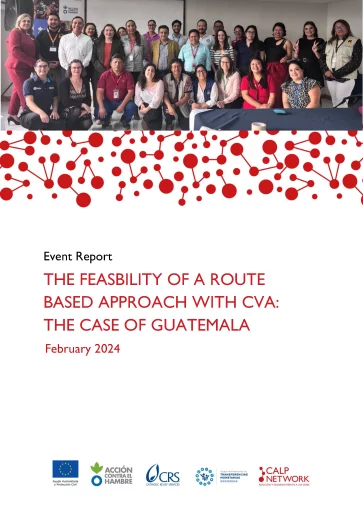
Event Report: The feasibility of a route-based approach with CVA: The case of Guatemala
Meeting minutes
In 2022, CALP recognized the importance of human mobility and CVA and invited its network to contribute to the evidence and debate. CALP conducted the study People are on the move: Can the world of CVA keep up? Analysis of the use of CVA in the context of human mobility in the Americas examined the use of CVA with people on the move. It also conducted several online exchanges on human mobility...

Onward Bound: Evaluating Cash and Voucher Assistance for Migrants on Sahel’s Migration Trail – Research and learnings from the Sahel region
Report
This research – a collaboration between the British Red Cross and Samuel Hall – provides evidence on the opportunities and challenges to integrate cash and vouchers assistance (CVA) as a support modality in migration programming in the context of transit migration in the Sahel. While CVA has become increasingly common and popular among implementing agencies and donors, there is limited...

DIGNIFYING, DIVERSE AND DESIRED: CASH AND VOUCHERS AS HUMANITARIAN ASSISTANCE FOR MIGRANTS
Report
This report looks at the use of Cash and Voucher Assistance (CVA) in supporting migrants. This report includes a baseline review of the use of CVA in the IFRC’s past and current operations assisting migrants, finding that in a 42-month period between 2018 and 2021, CVA was used in 25 per cent of the IFRC’s emergency responses assisting migrants. The report highlights over 35 diverse...
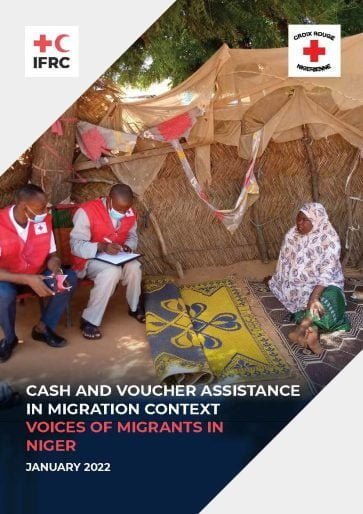
CVA in Migration Context – Voices of Migrants in Niger
Report
On 24–31 August 2021, the Niger Red Cross, supported by the IFRC, conducted a survey with 35 migrants in neighbourhoods around the capital city of Niamey to ask about their views on CVA, their preferences, and their views on digital identities. This report provides a summary of the responses from the migrant communities.
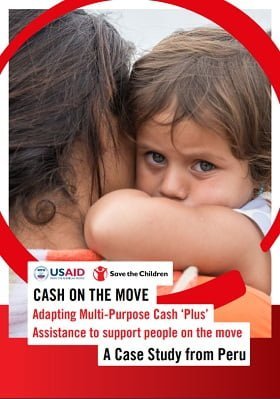
CASH ON THE MOVE – Adapting Multi-Purpose Cash ‘Plus’ Assistance to support people on the move in Peru
Report
In 2019 and 2020, with the support of USAID´s Bureau for Humanitarian Assistance (formerly FFP and OFDA), Save the Children implemented
a multi-purpose cash ‘Plus’ program in response to the influx of Venezuelan migrants into Peru.
Households that were only transiting through the cities where they were identified were provided with a one-off cash transfer assistance aiming
at covering...

Cash Transfers Programs and Human Mobility: Sharing experiences, debates, and learnings
Report
Cash Transfers have been one of the commitments of the Grand Bargain in which significant progress has been made. It should be noted that the challenges posed by different humanitarian contexts also oblige us to improve and revise these modalities of assistance in complex situations. The large flows of human mobility urgently require a design of solutions focused on transforming the system for...

IOM Cash-Based Interventions Annual Report and Case Studies 2020
Case Study
The IOM Cash-Based Interventions (CBI) Annual Report and Case Studies 2020 features case studies from a large number of missions that implemented CBI in 2020 and highlights the increasing use of cash and voucher assistance in IOM, reaching more than 1.6 million beneficiaries in 56 countries. The case studies give an overview of the broad range of CBI implemented by IOM and are divided into...

CVA in migration context – Voices of migrants in Kenya
Report
This report summarizes community consultations that were conducted in Kakuma refugee camp and Kalobeyei integrated settlement. It introduces the local context and the current user journey, experiences and preferences around cash and voucher assistance and digital identity solutions.
Thematic Leads
Latest

Colombia and Lebanon Evaluation Report: Measuring the impact of cash on child protection outcomes
Report
As humanitarian crises break down traditional protection mechanisms and the loss of income restricts access to basic resources, children become increasingly vulnerable to abuse, neglect, exploitation, and violence. Cash and Voucher Assistance (CVA) is a critical modality that is increasingly being adopted...

Cash & Voucher Assistance (CVA) & Child Protection (CP) Global Study – Research Report in the DRC, Egypt, Lithuania and the Philippines
Report
Since 2022, Save the Children has been scaling up its use of CVA for Child Protection (CP) programming through various pilot projects.
Research was commissioned in four countries in 2022-23 to generate evidence and learning to inform the design of future programming but also to design a robust...
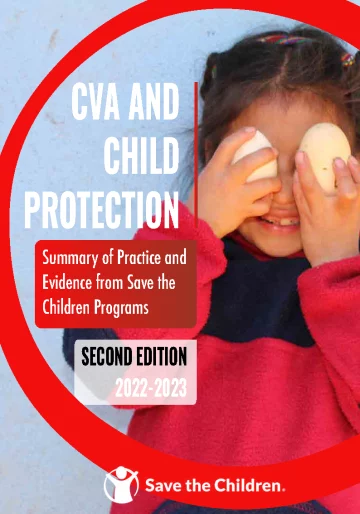
Cash and Vouchers Assistance (CVA) and Child Protection: Summary of practice and evidence from Save the Children programmes 2023 Edition
Report
In an effort to increase global knowledge and learning, Save the Children conducted a global review of twenty Country Offices and their programs in order to assess and highlight the impact that different forms of Cash and Vouchers Assistance (CVA) have on Child Protection (CP) outcomes, to identify...
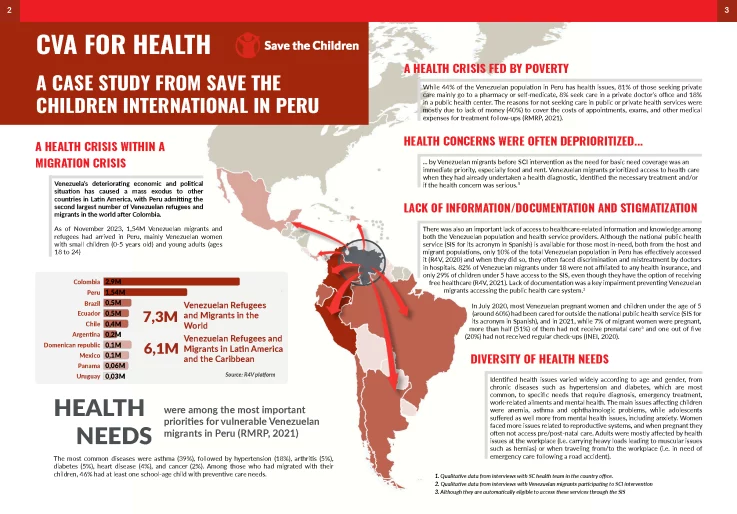
Cash & Voucher Assistance (CVA) for Health Outcomes: a case study in Peru
Case Study
This case study is drawn from Save the Children CVA operations in Peru between 2021 and 2023, focusing on the achievement of health outcomes for vulnerable Venezuelan migrants.
Following an overview of the contexts and of the needs, it deep dives into the technical design of the integrated program,...
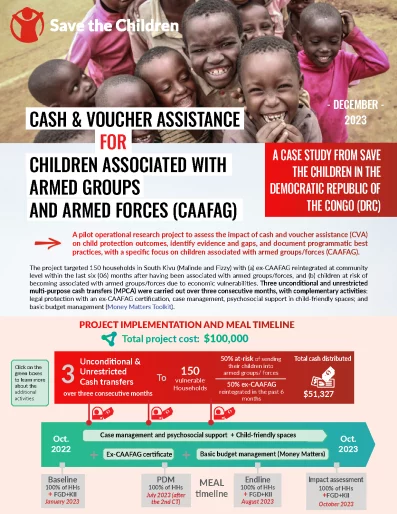
Cash and Voucher Assistance (CVA) for Children Associated with Armed Groups and Armed Forces (CAAFAG): Program Summary and Evidence-Building Infographic: A case study from Save the Children in the Democratic Republic of the Congo (DRC)
Case Study
This infographic gathers key programmatic data from Save the Children CVA operations in the DRC (South Kivu) between October 2022 and October 2023, which aimed to assess and highlight the impact that CVA has on child protection outcomes, with a specific focus on children associated with armed...

Lithuania Cash and Voucher Assistance (CVA) for Child Protection (CP): Program Summary and Evidence-Building Infographic
Case Study
This infographic gathers key programmatic data from Save the Children CVA operations in Lithuania, within the larger context of the Ukrainian crisis, between December 2022 and April 2023, which aimed to assess and highlight the impact that CVA has on child protection outcomes, with a specific focus on...

Egypt Cash and Voucher Assistance (CVA) and Child Labor: Program Summary and Evidence-Building Infographic
Case Study
This infographic highlights the main findings and achievements of Save the Children CVA operations in Egypt between March 2023 and November 2023, which aimed to assess and highlight the impact that CVA has on child protection outcomes, with a specific focus on unaccompanied and separated refugee children...
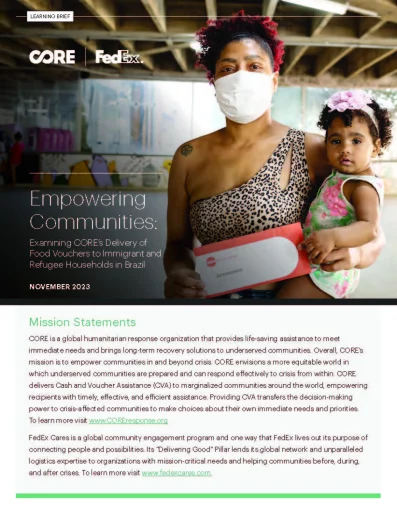
Empowering Communities: Examining CORE’s Delivery of Food Vouchers to Immigrant and Refugee Households in Brazil
Case Study
In 2022 alone Brazil hosted more than 560,000 refugees, asylum-seekers, stateless individuals and other individuals needing international protection. With year-on-year increase this trend is likely to continue. Although the government of Brazil does extend several protections to refugees—including...

Joint Market Assessment Round 2
Report
This report assesses the feasibility of implementing Cash and Voucher Assistance (CVA), specifically Multipurpose Cash Assistance (MPCA), to support individuals impacted by the February 6 earthquakes. The evaluation focuses on the acceptance of various forms of cash modalities, availability of key items,...

WVI Cash Roadmap 2.0 – New Avenues – Leveraging, multiplying “Nexus” cash to take children and their families further than imagined
Policy paper
WVI's strategic global Cash Roadmap 2.0 (2024-2027) speaks to the organisations' commitment that amidst polycrises and resourcing constraints, there is urgency to maximise and multiply World Vision's capabilities, assets and cash voucher programming (CVP=CVA) is a powerful tool to do so.
Increasing...

It’s time for a route-based approach in CVA programming: Unpacking the criteria to meet the needs of people on the move
Webinar recording
During this event, we discussed the key findings and proposals from our recent study “Mapping a Route-Based Approach to CVA: Feasibility in Select Contexts in the Americas”, including which are the benefits of adopting such an approach.

It’s time for a route-based approach in CVA programming: Unpacking the criteria to meet the needs of people on the move
Webinar
During this event, you learn about the key findings and proposals from our recent study “Mapping a Route-Based Approach to CVA: Feasibility in Select Contexts in the Americas”, including which are the benefits of adopting such an approach.

Somali Capacities to Respond to Crisis are Changing; How are humanitarian actors responding?
Report
Somalia’s most recent humanitarian crisis (2022–23) was severe, with an unprecedented series of failed rainy seasons leading to widespread suffering and significant excess mortality. The drivers of the near-famine – drought, conflict, and fragile governance – were largely similar to previous...

Cash on the Move – Lessons Learnt from the Ukraine Regional Response
Case Study
This report focuses on key programmatic and operational lessons learnt from SC’s Ukraine regional response in the use of CVA as a tool to provide assistance to populations on the move. It is organized around key enablers, challenges and recommendation during start up, implementation and monitoring of...

Ukraine Regional Response – Save the Children CVA Infographic
Report
This infographic gathers key programmatic data from Save the Children CVA operations in the Ukraine response, between February 2022 and September 2023. It highlights key programmatic design aspects (including transfer values and targeting approaches) and also illustrates the impact of CVA on multiple...

Mapping a Route-Based Approach to CVA: Feasibility in select contexts in the Americas
Report
This research looks at the feasibility of a route-based approach to CVA in the Americas, presenting its potential through three perspectives: people on the move, humanitarian organizations, and financial service providers (FSP).

Four Reasons to Use a Route-Based Approach to Cash and Voucher Assistance
Blog Post
With human mobility being a fact of most humanitarian crises, is it time to change from a country to a route-based approach? With four key points, Holly Welcome Radice argues the time for a route-based approach has arrived.

Cash Transfers Programs and Human Mobility: Sharing experiences, debates, and learnings
Report
Cash Transfers have been one of the commitments of the Grand Bargain in which significant progress has been made. It should be noted that the challenges posed by different humanitarian contexts also oblige us to improve and revise these modalities of assistance in complex situations. The large flows of...

Onward Bound: Evaluating Cash and Voucher Assistance for Migrants on Sahel’s Migration Trail – Research and learnings from the Sahel region
Report
This research – a collaboration between the British Red Cross and Samuel Hall – provides evidence on the opportunities and challenges to integrate cash and vouchers assistance (CVA) as a support modality in migration programming in the context of transit migration in the Sahel. While CVA has become...

Open Partner Survey for Cash and Voucher Assistance (CVA) in Response to a Crisis
Report
The open partner survey for cash and voucher assistance (CVA) in response to a crisis is a collaborative effort between REDLAC and the Regional Cash Working Group (R4V), with technical support from CashCap/NORCAP and the participation of multiple organizations. This report provides an analysis of the...



